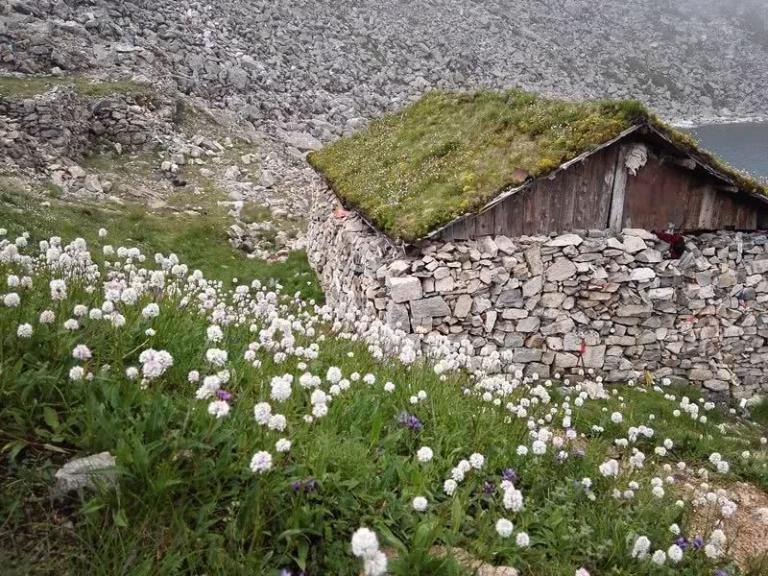Stone Man of Nanshan Pasture
4 min readThe scene of Stone Men is a major historical and cultural landscape on grasslands in Xinjiang, and the Stone Men are the lifelike statues carved by stones. They are buried in the tombs or guard in front of the tombs facing to the east-the direction where the sun rises, and where life consciousness and power can be revived.
The Stone men on Argonne Getty Prairie were carved by whole blocks of rocks. From the appearance, some are the full-length statues with vivid heads, faces, and bodies carved in lively lines. Some are in delicate modeling with countable jewelry pieces. And some are the big stones carved slightly by several lines, showing roughly the outline of the faces The collar of the clothes is round. There are two circular belllike devices on right and left of the chest, and there is zigzag anaglyph thing at the junction of the collar. There is one stone man with a round face and eyes, a straight nose and a small mouth, and there is a triangle pattern decorated on the chest. There is also a warrior stone man holding a knife in the left hand, and the right hand stretching out with the palm flipped upwards, as if saying “please”in a martial arts fightthe waistband is carved nicely with a round bag hanging on the right shoulder, and it is dignified with the handlebar mustache.

Stone men not only distribute in Xinjiang Uygur Autonomous Region in China, but also throughout the Eurasian steppe. At present, more than 200 Stone men have been found in Xinjiang, which are mainly in ten cities and prefectures, such as Altai Mountains, Tianshan Mountains, Kazak Autonomous Prefecture of Ili in the western mountains of Junggar Basin, Altay Prefecture, and Tacheng, and Bortala Mongol Autonomous Prefecture.
Altay Prefecture is the region of most abundant stone men on the grasslands in Xinjiang, and more than 80 statues have been found. The highest one is 3.1m high and 2.7m above the ground; the shortest one is only 0.6m above the ground. According to the archaeological findings, there were cemetery stone men in the Bronze Age in Altay Prefecture, containing two types of Samute and Kainal. The Samute cemetery stone men in Qinghe County are the most typical among the Samute stone men, with the characteristics of only emphasizing the face organs: round face and eyes; triangle nose, wide alar part, and flat bottom; zygomatic bone is obvious, and the mouth is big. The most typical Kainal stone men are those in Qiemuerqieke Town in Altay City; those stone men were not only carved with faces, but also with arms. They are stylized lack of realism. They are carved with round or peach shaped faces, round eyes, square straight noses, small mouths, and triangle patterns on the shoulders and chest According to research, the stone men of the Bronze Age in the Altay Prefecture are closely related to the culture of “ghost kingdom” people recorded in history of China.
Chinese famous archaeologist Mr. Huang Wenbi found several Stone men in the 1950s when he inspected Ili in Xinjiang. After a preliminary study, he first proposed the point of view of “Xinjiang Stone men on the Grassland are Turkic Stone men”.
The Turkic Khanate was established in the mid-6th century and perished in the mid-9th century, lasting for more than 280 years The warrior type stone men found in Kazakhstan, Kyrgyzstan, and Turkmenistan in Central Asia, and Mongolia and Xinjiang, China were the only things that witnessed the history left by the Turkic Khanate.
The stone men on Argonne Getty Prairie were carved by whole blocks of rocks. From the appearance, some are the full-length statues with vivid heads, faces, and bodies carved in lively lines. Some are in delicate modeling with countable jewelry pieces. And some are the big stones carved slightly by several lines, showing roughly the outline of the faces The highest one is over 3m high and the shortest one is only 0.6m high. The collar of the clothes is round. There are two circular bell-like devices on right and left of the chest, and there is zigzag anaglyph thing at the junction of the collar. There is one stone man carved with round face and eyes, straight nose and small mouth, and there is a triangle pattern decorated on the chest. There is also a warrior stone man holding a knife in the left hand, and the right hand stretching out with the palm flipped upwards; the waistband is carved nicely with a round bag hanging on the right shoulder and it is dignified with the handlebar mustache.









